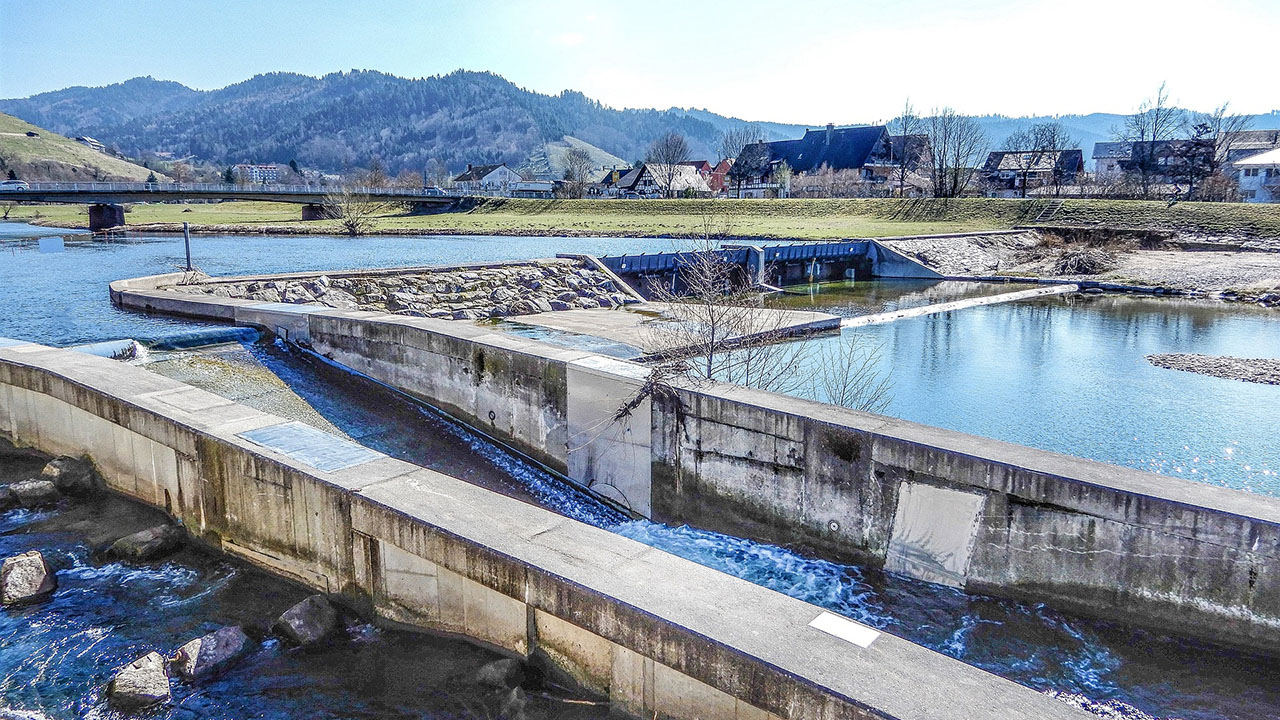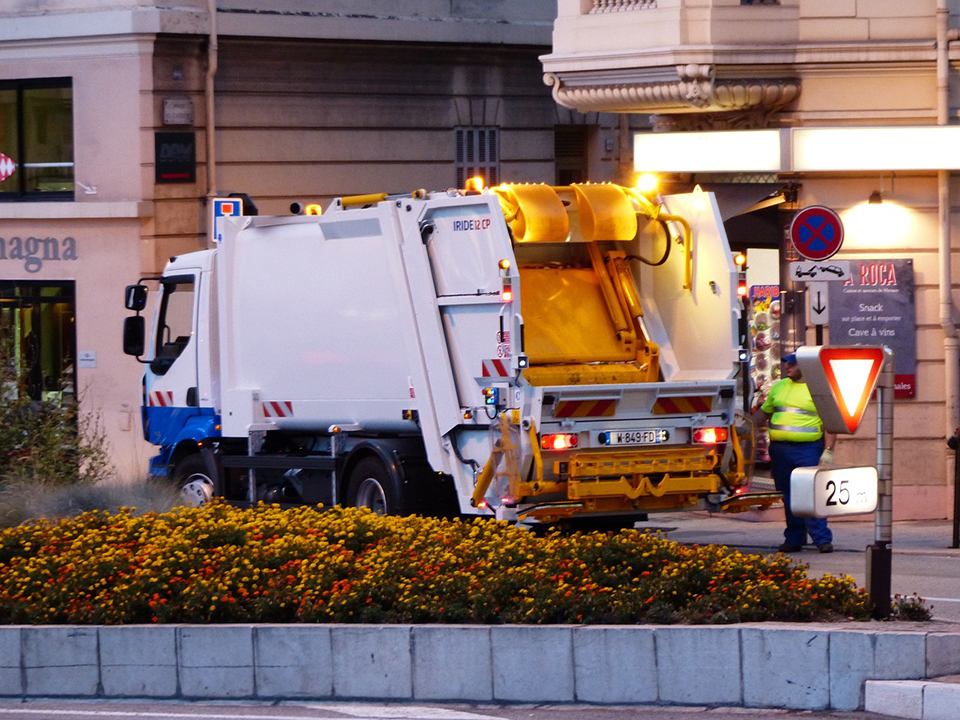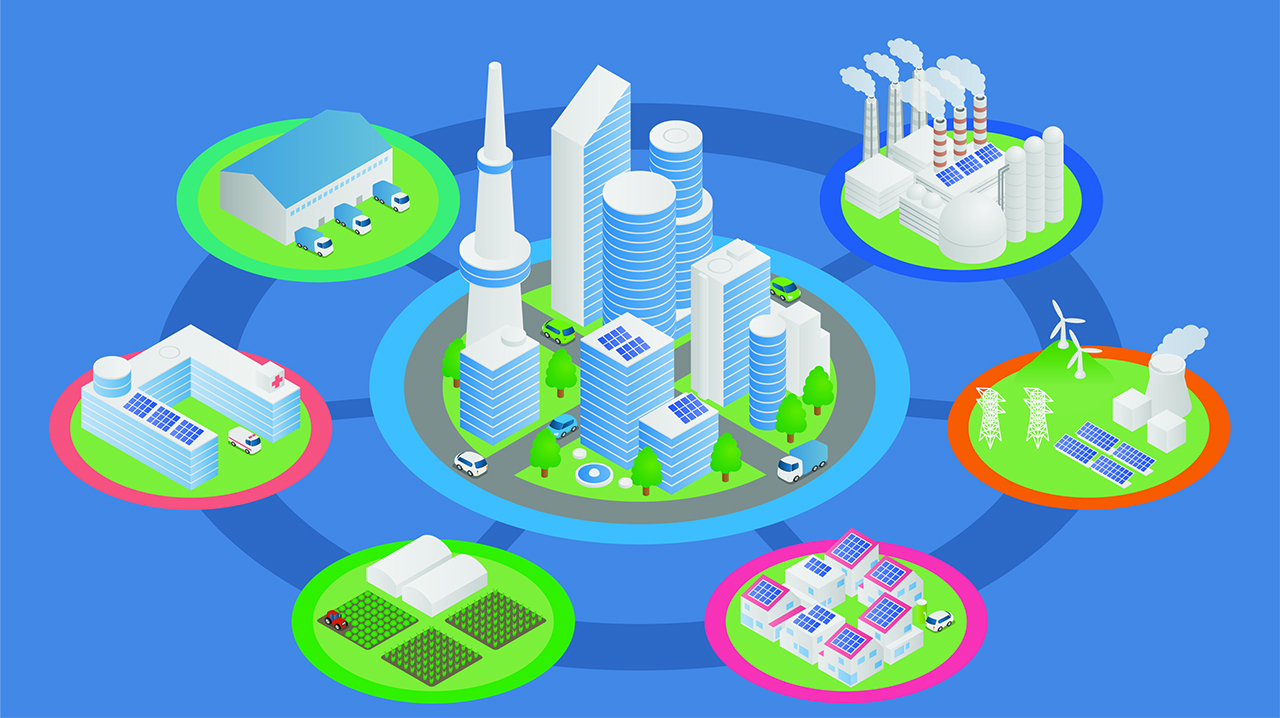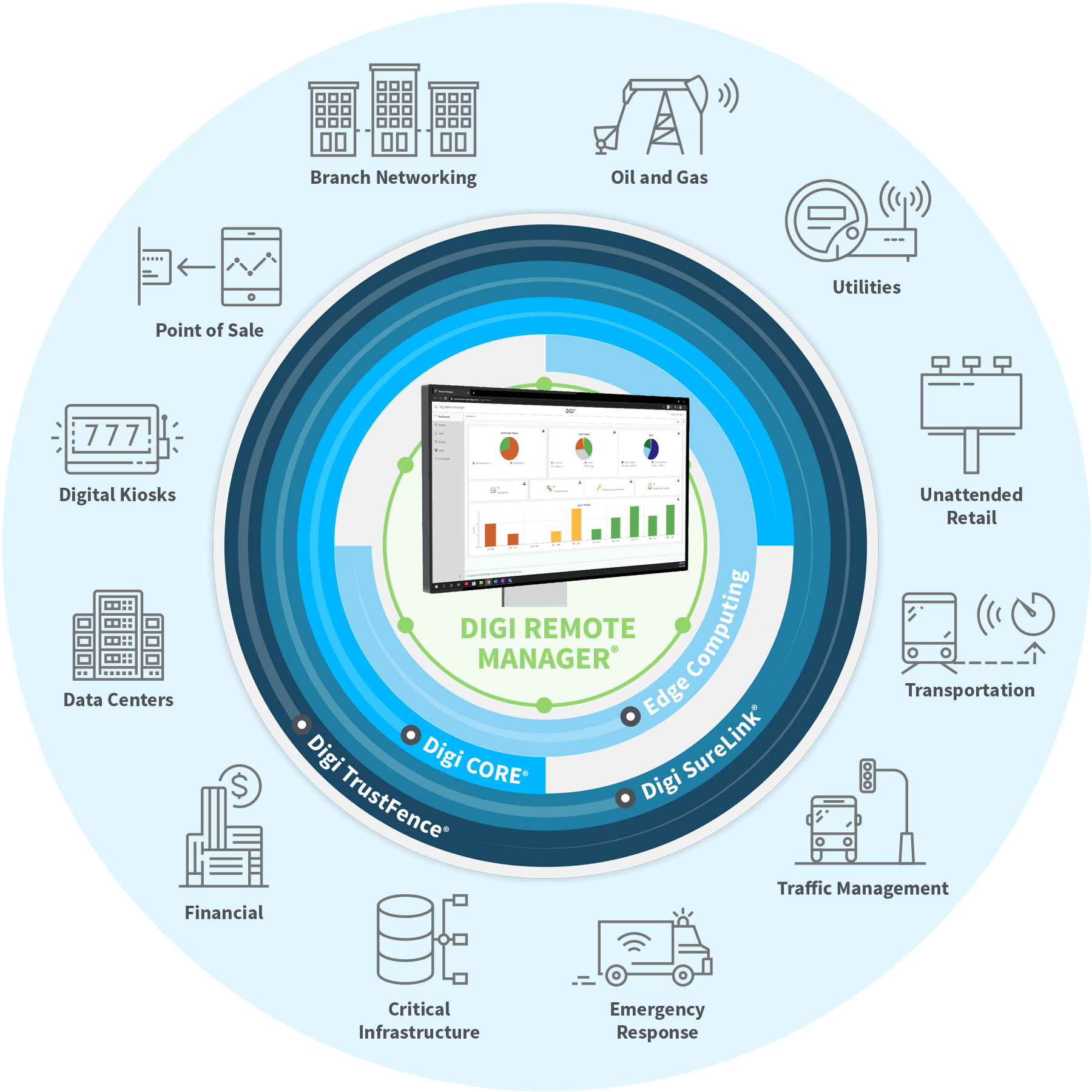Willkommen in der IoT City, in der vernetzte Geräte massive Veränderungen bewirken. Städte müssen mehr denn je zahlreiche Herausforderungen bewältigen - von der Verringerung von Verkehrsstaus über die Abwasser- und Abfallentsorgung bis hin zum Umweltschutz und der Senkung des Energieverbrauchs. Aus diesem Grund spielt das Internet der DingeIoT) in fast allen Bereichen der modernen Stadtverwaltung eine immer wichtigere Rolle bei industriellen Anwendungen, im öffentlichen Nahverkehr, bei der öffentlichen Sicherheit und bei Notdiensten, bei der Stadtbeleuchtung und anderen Anwendungen.
IoT und Smart Cities gehen heute Hand in Hand. Mit ausgefeilter IoT können Kommunen Konnektivität und datengesteuerte Intelligenz in allen Bereichen nutzen - von intelligenten Gebäuden über vernetzte Fahrzeuge und Ladestationen für Elektrofahrzeuge bis hin zu Mitfahrgelegenheiten, öffentlichem Nahverkehr und städtischen Versorgungsbetrieben. IoT für Smart Cities ermöglicht es städtischen Zentren, die Effizienz ihrer Infrastruktur zu steigern, die Zuverlässigkeit und Reaktionsfähigkeit von Notdiensten zu verbessern, die Lebensqualität in der Stadt zu erhöhen, Kosten zu senken und vieles mehr. Wir können davon ausgehen, dass es noch viele weitere Beispiele für die Anwendung des IoT in Smart-City-Initiativen geben wird.
Der Markt für IoT in Smart Cities
Laut Expert Market Research wurde der globale Markt für intelligente Städte im Jahr 2023 auf etwa 1,14 Billionen US-Dollar geschätzt und wird bis 2032 voraussichtlich auf 4,14 Billionen US-Dollar anwachsen - eine CAGR von 15,3 %. Darüber hinaus entfielen 2023 mehr als 35 % des Marktanteils auf das Segment der intelligenten Infrastruktur - einschließlich intelligenter Netze, Energiemanagementsysteme, Wassermanagementsysteme und Abfallmanagementlösungen.

Haupttreiber für IoT Anwendungen in intelligenten Städten
Was treibt die Investitionen in die Anwendung des IoT in Smart-City-Initiativen an?
- Die Kosten sind ein wichtiger Faktor für die Verlagerung von kabelgebundenen zu drahtlosen Lösungen, da die Installation und Wartung von Festnetzanschlüssen sehr teuer ist. Darüber hinaus ermöglichen die sinkenden Kosten für Mobilfunk zusammen mit den verbesserten drahtlosen Kommunikationsfähigkeiten Anwendungsfälle, die zuvor nicht finanzierbar waren.
- Auch die Effizienz spielt eine entscheidende Rolle. Bei kabelgebundenen Lösungen sind häufig Vor-Ort-Besuche zur Überprüfung und Wartung der Infrastruktur erforderlich, was zu kostspieligen und ineffizienten "Lastwagenfahrten" führt. Im Gegensatz dazu ermöglicht die drahtlose Kommunikation die Fernüberwachung und -verwaltung von IoT und ermöglicht Firmware-Updates, Sicherheits-Patches und automatische Problembenachrichtigungen.
- Die Reduzierung der Ressourcen ist ein weiterer wichtiger Beweggrund, insbesondere bei Anwendungen wie der intelligenten Straßenbeleuchtung und der Anlagenüberwachung. Diese IoT nutzen Sensoren und drahtlose Module, um die Ressourcennutzung zu steuern und den Energieverbrauch deutlich zu senken.
- Intelligente Energienutzung und Nachhaltigkeit sind von entscheidender Bedeutung, da die Städte nach neuen und effizienten Wegen suchen, um den Ressourcenverbrauch zu reduzieren, den CO2-Fußabdruck zu verringern und den städtischen Betrieb zu verbessern. Diese Praktiken fördern langfristig die Gesundheit der Umwelt und Kosteneinsparungen und sorgen dafür, dass Städte lebenswert und widerstandsfähig bleiben.
Die IoT Infrastruktur für Smart Cities
Eine skalierbare, sichere und zukunftsfähige IoT für intelligente Städte umfasst eine Reihe von Hardware- und Softwarekomponenten.
- Sensoren - In der gesamten IoT erfassen Sensoren eine große Anzahl von Datenpunkten für die Automatisierung, Entscheidungsfindung, Berichterstattung und Einhaltung von Vorschriften. Dazu gehören:
- Umweltsensoren in intelligenten Städten überwachen Luftqualität, Lärm, Temperatur und andere Bedingungen in Echtzeit, um die öffentliche Gesundheit zu verbessern, die Stadtplanung zu optimieren und datengesteuerte Entscheidungen zu unterstützen.
- Verkehrssensoren in IoT für intelligente Städte überwachen den Fahrzeugfluss, Staus und die Geschwindigkeit in Echtzeit, um die Zeitsteuerung von Verkehrssignalen zu optimieren, Verspätungen zu verringern, die Sicherheit im Straßenverkehr und für Fußgänger zu verbessern und Emissionen zu reduzieren.
- Versorgungssensoren ermöglichen die Überwachung des Wasser-, Gas- und Stromverbrauchs in Echtzeit, um Lecks zu erkennen, Ausfälle zu verhindern und eine effiziente Ressourcenverwaltung in intelligenten Städten zu unterstützen.
- Überwachungssensoren wie Kameras und Bewegungsmelder verbessern die öffentliche Sicherheit, indem sie Sicherheitsbedrohungen oder unbefugte Aktivitäten erkennen.
- Infrastruktur-Sensoren überwachen den Zustand von Brücken, Straßen und Gebäuden, um strukturelle Probleme zu erkennen und Ausfälle zu verhindern.
- Parksensoren können die Verfügbarkeit von Parkplätzen erkennen, um den mit der Parkplatzsuche verbundenen Zeitaufwand und die Emissionen zu reduzieren.
- Konnektivität - Durch den Einsatz von Mobilfunk, Bluetooth- und Wi-Fi-fähigen Geräten liefert die Smart-City-Infrastruktur Intelligenz und Erkenntnisse und ermöglicht so die Koordinierung von Diensten und Behörden sowie die Reduzierung von Abfall und eine verbesserte betriebliche Effizienz.
- Instrumentierung - Mithilfe von regelbasierten Bedingungen und Sensorwarnungen kann der Smart-City-Betrieb aus der Ferne und automatisch Infrastrukturen aktivieren, wie z. B. das Öffnen von Toren und Überführungen, die Neukonfiguration von Ampelschaltungen, die Änderung der Straßenbeleuchtung und vieles mehr.
- Datenrepositories - Eine zentrale Datenbank (z. B. ein Data Warehouse oder ein Data Lake) speichert Transaktionsdaten und führt anspruchsvolle Analysen durch, die Vorhersagemodelle ermöglichen, die KI und statistische Algorithmen nutzen, um Muster und Korrelationen zu erkennen.
- Zentrale Verwaltung - Eine ausgefeilte Verwaltungsanwendung ermöglicht es Administratoren, vernetzte Geräte in der gesamten Kommune aus der Ferne und zentral bereitzustellen, zu diagnostizieren, Fehler zu beheben und zu reparieren - wie z. B. Mobilfunk , die an Kreuzungen zur Verkehrsüberwachung und für V2X-Anwendungen eingesetzt werden.

IoT und Smart Cities in Aktion
Die Initiativen für intelligente Städte IoT reichen vom Verkehrsmanagement über den öffentlichen Nahverkehr bis hin zur Stadtbeleuchtung und mehr. Schauen wir uns einige Beispiele von Digi's Kundeneinsätzen an.
Öffentliche Verkehrsmittel

Verkehrssysteme sind ein idealer Anwendungsfall für IoT , mit denen die Kosten erheblich gesenkt, die Sicherheit erhöht, die Routen optimiert und der Komfort für die Fahrgäste verbessert werden können.
Viele Kommunen, die zuvor mit rückläufigen Fahrgastzahlen konfrontiert waren, verzeichnen nun dank der verbesserten Transparenz der Bus- und Bahnrouten sowie der verbesserten Wi-Fi-Konnektivität für Fahrgäste durch den Einsatz von Mobilfunk 5G-Verkehrsroutern ein Wachstum. Durch die Analyse eingebetteter Sensoren können Verkehrsbetriebe öffentliche Nutzungsmuster erkennen, die Sicherheit gewährleisten und die Pünktlichkeit verbessern.
Digi IoT Smart City Transit Lösungen in Aktion
- TriMet (Tri-County Metropolitan Transportation District of Oregon) betreibt eine Flotte von über 700 Bussen auf 85 Routen mit Tausenden von Haltestellen im gesamten Stadtgebiet von Portland. In jedem Bus befindet sich ein Digi TX64 Transportrouter, der von Digi Remote Managerverwaltet wird, ermöglicht TriMet die Nutzung der CA/AVL-Technologie und die elektronische Fahrpreiserfassung, neben anderen vernetzten Anwendungen. Darüber hinaus unterstützen die Digi-Router die preisgekrönte Transit Signal Priority-Initiative der Behörde zur Optimierung der Buslinienführung, zur Kapazitätserweiterung und zur Verbesserung der Fahrgastfreundlichkeit.
- Mit Digi Remote Manager gepaart mit Digi's speziell entwickelten Transportroutern, die in Hunderten von Bussen installiert sind, bietet Pittsburgh Regional Transit den Fahrgästen Echtzeitinformationen über Fahrpläne, Standorte und Fahrgastdichte sowie einen kostenlosen Wi-Fi-Service - alles im Rahmen des Ziels, die Fahrgastzahlen im öffentlichen Nahverkehr zu verbessern.
- Im Großraum Boston tankt, reinigt, inspiziert und wartet die Massachusetts Bay Transit Authority (MBTA), eine der größten und ältesten Verkehrsbetriebe der Welt, mehr als 1.000 Busse auf organisierte, methodische und dokumentierte Weise. Dies geschieht mit Hilfe von Fleetwatch von S&A Systems, einer leistungsstarken Hardware-/Softwarelösung, die von einem eingebettetenDigi XBee 3 Zigbee 3 RF-Modul in jedem Bus gesteuert wird, das über 2,4 GHz Daten sendet und empfängt. Das Ergebnis: zuverlässige und genaue Echtzeit-Steuerung und Datenerfassung für Fahrzeuge, Mitarbeiter, Kraftstoff/Flüssigkeiten und Tanküberwachungssysteme.
Lesen Sie mehr über Smart-City-Anwendungen IoT für Busse und Stadtbahnen in unseren Kundenberichten.
Intelligentes Verkehrsmanagement
 Mit IoT Sensoren in Fahrzeugen, Smartphones und Ampeln sowie Straßenkameras, Mobilfunk Transport-Router können Daten über Verkehrsbedingungen, Staus und Unfälle sammeln und helfen, längerfristige Muster auf der Grundlage von Tages- und Jahreszeiten zu erkennen.
Mit IoT Sensoren in Fahrzeugen, Smartphones und Ampeln sowie Straßenkameras, Mobilfunk Transport-Router können Daten über Verkehrsbedingungen, Staus und Unfälle sammeln und helfen, längerfristige Muster auf der Grundlage von Tages- und Jahreszeiten zu erkennen.
Diese hochentwickelten Lösungen ermöglichen es den Verkehrsmanagementteams, den Verkehr umzuleiten, um unerwartete Staus zu vermeiden oder aufzulösen und die Routenführung des öffentlichen Nahverkehrs und der Rettungsfahrzeuge zu verbessern.
Eine Digi IoT Smart City Verkehrsmanagement-Lösung in Aktion
- Das New York City Department of Transportation verwaltet eines der komplexesten städtischen Verkehrsnetze der Welt mit 6.300 Meilen an Straßen und Autobahnen, über 12.000 Meilen an Gehwegen, fast 14.000 signalisierten Kreuzungen und 800 Brücken und Tunneln. In Zusammenarbeit mit mehreren Anbietern und Behörden rüstete die Stadt ihr stadtweites Verkehrssystem mit dem Digi Remote Manager® (Digi RM), einem dualen Digi Mobilfunk an jeder Kreuzung sowie kundenspezifischer Digi-Software und -Services auf. Diese groß angelegte Implementierung wurde innerhalb von neun Monaten und unter dem Budget abgeschlossen.
Laden Sie unser Solution Brief herunter
Erfahren Sie mehr über intelligente Verkehrsmittel und Notfallvorsorge
PDF herunterladen
Wasserwirtschaft
 Die Wasserwirtschaft hat hohe Priorität, und das IoT spielt eine immer wichtigere Rolle bei IoT für intelligente Städte.
Die Wasserwirtschaft hat hohe Priorität, und das IoT spielt eine immer wichtigere Rolle bei IoT für intelligente Städte.
Staatliche Organisationen und Kommunen müssen veraltete Infrastrukturen mit leistungsstarken industriellen Mobilfunk Routern und Infrastrukturmanagementlösungen aufrüsten, die Effizienz steigern, die Transparenz bei entfernten Tanks und Wassermanagementprozessen verbessern und die Kosten für die Überwachung und Wartung ihrer Anlagen senken.
Digi IoT Smart City Wassermanagement-Lösungen in Aktion
- In Georgia versorgt das Augusta Utilities Department eine Bevölkerung von mehr als 160.000 Einwohnern auf einer Fläche von 230 Quadratmeilen mit Wasser und Abwasser - einschließlich etwa 1.200 Meilen an Wasserleitungen. Digi Connect® Sensor XRT-M hilft dabei, diese lebenswichtige Infrastruktur im Auge zu behalten, und sorgt für Intelligenz, Transparenz und Effizienz bei den wichtigen Überwachungs- und Wartungsprozessen.
- In ganz Nordamerika und im pazifischen Raum setzt Brown and Caldwell kreative Lösungen ein, um Kommunen, der Privatwirtschaft und Regierungsbehörden zu helfen, schwierige Wasser- und Umwelthindernisse erfolgreich zu überwinden. Verwendung von Digi Remote Manager und Digi Connect Sensor XRT-M verschafft das Unternehmen der Wasserinfrastruktur mehr Einblick und Innovation.

Abfallwirtschaft
IoT Lösungen in intelligenten Städten verbessern das Abfallmanagement durch Echtzeitüberwachung und Datenanalyse. Drahtlose Sensoren und Mobilfunk Konnektivitätsgeräte ermöglichen es den Städten, die Abfallmengen in den Behältern zu überwachen, die Sammelrouten zu optimieren und die Betriebskosten zu senken. Dies gewährleistet eine rechtzeitige Müllabfuhr, senkt den Kraftstoffverbrauch und minimiert die Umweltbelastung.
Eine Digi IoT Smart City Abfallmanagement-Lösung in Aktion
- Mit dem System iSmart IoT hilft Metro Compactor Service Inc. seinen kommunalen Kunden, die Infrastruktur ihrer Abfallentsorgungsanlagen proaktiv zu verwalten und deren Lebensdauer zu verlängern, um einen produktiven und effizienten Betrieb sicherzustellen. Digi Industrial Mobilfunk Router und Digi RM spielen eine entscheidende Rolle, da sie dafür sorgen, dass die Geräte jederzeit miteinander verbunden sind. Das bedeutet weniger Verdichtungen, weniger Energieverbrauch, weniger Wartungsaufwand und weniger frustrierende Überkapazitätssituationen.
In unseren Kundenberichten finden Sie weitere Beispiele für Lösungen im Bereich Wasser- und Abwassermanagement.

EV-Laden
Die Infrastruktur für IoT ermöglicht effiziente Ladenetzwerke für Elektrofahrzeuge (EV). Drahtlose Konnektivität, Sensoren und Fernverwaltungsplattformen ermöglichen es Städten, Ladestationen für Elektrofahrzeuge in Echtzeit zu überwachen und zu verwalten. Dies gewährleistet eine optimale Energieverteilung, reduziert Ausfallzeiten und verhindert eine Überlastung des Stromnetzes.
Darüber hinaus helfen Datenanalysen den Städten bei der Planung der strategischen Platzierung von Ladestationen, um die Zugänglichkeit und den Komfort für die Bürger zu gewährleisten. Diese Lösungen unterstützen das Wachstum des nachhaltigen Verkehrs, verringern die Kohlenstoffemissionen und tragen zu einer effizienteren, zukunftsfähigen städtischen Infrastruktur bei.
Digi IoT Smart City EV charging Lösung in Aktion
- FLO, Kanadas größtes EV-Ladenetzwerk, betreibt ein umfassendes Ladesystem, das die Bedürfnisse der Autofahrer erfüllt, wo immer sie sich befinden - zu Hause, am Arbeitsplatz oder unterwegs. Die Ladestationen basieren auf Digi XBee Funkmodulen sowie auf industriellen Mobilfunk Gateways und eingebetteten System-on-Modules. FLO hat mehr als 80.000 Ladestationen in ganz Nordamerika verkauft und sein Netzwerk ermöglicht mehr als 1 Million monatliche Ladevorgänge.

Stadtbeleuchtung, digitale Beschilderung und Kameras
Beleuchtung, Beschilderung und Sicherheitskameras sind einige der besten Beispiele für die Implementierung von IoT Anwendungen für intelligente Städte, und viele Kommunen setzen heute auf drahtlose Kommunikation, um Effizienz, Kosteneinsparungen und Energieeinsparungen zu erzielen.
Digi-Lösungen für Stadtbeleuchtungs-, Digital Signage- und Sicherheitsanwendungen können eine Reihe von Lösungen umfassen, je nach der spezifischen Anwendung. Eine Organisation hat beispielsweise einen intelligenten Strommast entwickelt, bei dem robuste Digi Industrial Mobilfunk Router zum Einsatz kommen, die Drop-in-Konnektivität und Datenrouting für mehrere Geräteknoten auf dem intelligenten Mast bieten. Städte können auch eingebettete Lösungen wie Digi industrial Mobilfunk Gateways, gepaart mit Digi XBee® Modulen, verwenden. Diese Lösungen bieten vollständige Flexibilität zur Unterstützung einer Reihe von Anwendungen:
- LED-Beleuchtungssteuerung
- Überwachungskameras
- Umgebungssensoren
- Elektronische Werbetafeln
- Ladestationen
- Wi-Fi-Abdeckung
Digi IoT Smart City Lighting Lösungen in Aktion
- Dimonoff, ein Innovator auf dem Gebiet der drahtlosen Steuerungs- und Fernüberwachungstechnologien für Straßen- und Bereichsbeleuchtungen, kombiniert eingebettete Hardware und Back-End-Management-Software zu einer Lösung, die darauf ausgelegt ist, den Energieverbrauch zu reduzieren, die Betriebs- und Wartungskosten zu senken und die Sicherheit der Bürger zu erhöhen. Durch die Integration von Digi XBee DigiMesh 2.4-Modulen in seine Lösung schafft das Unternehmen ein sicheres Mesh-Netzwerk, das mit einem Hauptkontrollzentrum zur Datenerfassung und -planung kommuniziert. So können Administratoren die Straßenbeleuchtung über Sensoren, Schalter oder aus der Ferne konfigurieren und steuern. Das System verfolgt die Daten der Leuchten in Echtzeit, einschließlich Stromverbrauch, Spannung, Strom, Leistungsfaktor und Betriebsstatus, und gibt automatische Warnmeldungen aus.
- In Chile bietet Sicom Electronics den Kommunen CityMesh® an, ein skalierbares Smart-Cities-Netzwerk, mit dem sich Tausende von Straßenlaternen und Ampeln intelligent und mit größerer Präzision steuern lassen. Das Ergebnis: niedrigere Kosten, ein besserer ökologischer Fußabdruck und mehr Sicherheit für die Bürger. Digi XBee® RF-Module bieten die drahtlose Konnektivität, um dies zu ermöglichen.
- Die von Schréder entwickelte und in Mainz ansässige Owlet Nightshift nutzt die Digi-Konnektivitätshardware und ermöglicht es Städten, veraltete Beleuchtungsinfrastrukturen mit langlebiger intelligenter Technologie nachzurüsten. Jede intelligente Leuchte ist mit einem Hochleistungs-LED-Array und einem Digi XBee ZigBee-Modul ausgestattet. Mit Digi XBee können Gruppen von Leuchten ein ZigBee-Mesh-Netzwerk bilden, das über ein Digi Mobilfunk mit einem Mobilfunk verbunden ist.
Weitere Anwendungen für intelligente Stadtbeleuchtung finden Sie in unseren Kundenberichten zur Stadtbeleuchtung.

Intelligente Gebäude
Ein intelligentes Gebäude nutzt fortschrittliche Technologie und IoT zur automatischen Steuerung und Optimierung verschiedener Gebäudesysteme wie Heizung, Lüftung, Klimaanlage (HVAC), Beleuchtung, Sicherheit und mehr. Diese Systeme sind miteinander verbunden und können zentral verwaltet werden, oft über cloudbasierte Plattformen, um Effizienz, Komfort, Sicherheit und Nachhaltigkeit zu verbessern.
Die IoT von Digi bieten Edge Computing, zuverlässige Konnektivität, Skalierbarkeit, Sicherheit und Cloud-Integration. So können Sie Daten sammeln und Bedingungen in Echtzeit überwachen, Gebäudesysteme automatisieren und steuern, den Energieverbrauch senken, die Sicherheit erhöhen und den Komfort der Bewohner verbessern.
Digi IoT Smart Building Lösungen in Aktion
- NuOz unterstützt Gebäudeverwalter bei der Verwaltung ihres Energieverbrauchs in Echtzeit und bietet kontinuierlichen Zugriff auf Energiekennzahlen, die ihnen helfen, rechtzeitig Entscheidungen zu treffen, um Kosten zu senken, die betriebliche Effizienz zu verbessern und ihr Engagement für Nachhaltigkeitsziele zu stärken. Um diese Ziele zu erreichen, entschied sich NuOz für Digi Enterprise Mobilfunk Router und Digi Remote Manager für die Konnektivität und das Management der Sensoren in den Stromwandlern der elektrischen Schalttafeln des Gebäudes. Dadurch können sie präzise Daten auf Schaltkreisebene sammeln. Diese Sensoren kommunizieren über LoRaWAN® mit einem lokalen Server-Gateway, wo die Daten aggregiert und über die Cloud zu den NuOz-Servern zurückgespielt werden, auf denen die Kunden Nutzungsmetriken und -trends durchsuchen und aufschlüsseln können.
- Infinitum Electric hat sich zum Ziel gesetzt, mit seiner patentierten PCB-Statortechnologie, die intelligentere, leichtere, leisere und umweltfreundlichere Elektromotoren und Generatoren ermöglicht, die Elektrifizierungslandschaft neu zu gestalten. Digi XBee® Mobilfunk Modems spielen eine Schlüsselrolle in dieser Mission, da das Unternehmen auf große Möglichkeiten in HLK-Systemen abzielt, die überlegene Effizienz und Haltbarkeit bieten.

Versorgungsunternehmen, Smart-Grid- und Smart-Metering-Anwendungen
Intelligente Netze nutzen die zuverlässigen und sicheren Lösungen von Digi, einschließlich industrieller Konnektivität und Edge-Computing-Router, um die Energieverteilung zu optimieren, erneuerbare Quellen zu integrieren und dynamisch auf die Nachfrage zu reagieren. Intelligente Messsysteme, die von den sicheren Netzwerkgeräten von Digi betrieben werden, liefern Echtzeitdaten über den Energieverbrauch und ermöglichen so ein effizientes Ressourcenmanagement und personalisierte Einblicke für den Verbraucher. Diese Technologien verbessern nicht nur die Energieeffizienz, sondern unterstützen auch Nachhaltigkeitsziele, senken die Betriebskosten und geben den Bürgern mehr Kontrolle über ihren Energieverbrauch, wodurch Smart Cities widerstandsfähiger und umweltfreundlicher werden.
Digi IoT Smart Energy Lösungen in Aktion
- Der von E-GEARentwickelte Energy Management Controller (EMC). Dieses Gerät verwendet eine Reihe von Sensoren zur Spannungs- und Strommessung, um die Speicherung von Solarstrom in einer lokalen Batterie zu überwachen und zu steuern, und verwaltet anschließend die Abgabe dieser Energie an das Haus oder zurück an das Stromnetz in der von den Versorgungsunternehmen gewünschten gleichmäßigen, kontrollierten Weise. Mit dieser Glättungsfunktion können ganze Stadtteile als dezentrale Erzeugungs- und Speicherquellen für den Stromversorger fungieren. Dadurch verringert sich der Bedarf des Versorgungsunternehmens an überschüssiger Erzeugungskapazität und Spannungsschwankungen im Netz. Digi Remote Manager bot E-GEAR sofort eine hochfunktionale Cloud-Schnittstelle. Und die Art und Weise, wie EMC die System-on-Module von Digi nutzt, beschleunigte auch die Hardware- und Softwareentwicklung.
- Für E-DeMa, ein gemeinsames Pilotprojekt von SWK, RWE, Siemens, Miele, ProSyst, den Universitäten Bochum, Duisburg/Essen und Dortmund sowie der Fachhochschule Dortmund, hat Digi eine völlig neue, maßgeschneiderte Softwareanwendung entwickelt, die den Anforderungen des Projekts entspricht. Damit wird ein zukunftsfähiges Modell für Energieversorgungsunternehmen geschaffen, das die Verbraucher durch die Steuerung ihres Verbrauchs zu aktiven Marktteilnehmern macht. Die Kommunikationsverbindungen zwischen allen Komponenten und den Verbrauchern im Projekt werden von der Digi Extended Grid Solution Plattform verwaltet, die folgende Komponenten nutzt Digi Remote Manager und Digi Mobilfunk Gateways verwendet.
- ElectriCities of NCElectriCities, eine gemeinnützige Organisation, bietet eine Reihe von technischen Dienstleistungen zur Unterstützung der Stromversorgung in North Carolina, South Carolina und Virginia an. ElectriCities hat sich von einer veralteten Netzinfrastruktur (T1 und 56k-Modems) getrennt und sich für Digi Industrie-Router Mobilfunk weil sie die richtige Kombination aus Zuverlässigkeit, Sicherheit, Kontrolle und Flexibilität bieten.

Wie Smart Cities von der Digitalisierung profitieren IoT
Die Anwendung von IoT in Smart-City-Projekten hat eine neue Ära der Stadterneuerung eingeläutet, die es den Städten ermöglicht, ihre Effizienz zu steigern, eine bessere Kontrolle über die Ressourcennutzung zu erlangen und das Leben ihrer Bürger zu verbessern. Zu diesen Verbesserungen gehören zum Beispiel:
Verbesserte Verwaltung der kommunalen Ressourcen: Intelligente Städte nutzen die IoT, KI und Big-Data-Analysen, um die Verwaltung ihrer Verkehrs-, Wasser- und Energieressourcen zu verbessern. Das Ergebnis: Kosteneinsparungen, weniger Abfall und mehr Effizienz.
Größere Nachhaltigkeit: IoT Cities sind bestrebt, nachhaltiger zu sein, indem sie den Energieverbrauch senken und die Nutzung von erneuerbaren Energien fördern. Initiativen für eine nachhaltige Stadt tragen dazu bei, Abfall zu reduzieren, die Widerstandsfähigkeit der Stadt zu erhöhen und grüne Energiestrategien zu fördern.
Sauberere Luft: Insgesamt fördern Smart-City-Anwendungen und Green-Tech-Initiativen nicht nur die Nachhaltigkeit, sondern verringern auch die Treibhausgasemissionen, die zu Umweltverschmutzung und Luftqualitätsproblemen beitragen. Von intelligenten Gebäuden, die den Energieverbrauch drastisch senken, über Verkehrsmanagementsysteme, die den Verkehrsfluss optimieren und den Leerlauf von Bussen reduzieren, bis hin zu Mikromobilitätsprojekten, die Pendler dazu ermutigen, statt mit benzinbetriebenen Autos mit menschen- und elektrobetriebenen Fahrzeugen zu fahren, verringern all diese Initiativen die Emissionen und den CO2-Fußabdruck, setzen weniger Schadstoffe frei und verbessern die Luftqualität für die Stadtbewohner.
Wirtschaftswachstum: Intelligente Städte fördern das Wirtschaftswachstum, indem sie ein besseres Umfeld für neue Unternehmen - und Arbeitsplätze - schaffen.
Bessere Lebensqualität: In einer intelligenten Stadt genießen die Bürger dank Daten und Technologie einen viel höheren Lebensstandard. Das führt zu besseren Dienstleistungen in den Bereichen Gesundheit, Bildung und öffentliche Sicherheit. Darüber hinaus führen diese verbesserten Dienstleistungen zu mehr bürgerschaftlichem Engagement.
Die Anwendungen von IoT in intelligenten Städten sind eine zukunftsweisende Strategie zur Schaffung eines lebenswerteren, nachhaltigeren und effizienteren städtischen Umfelds, das den heutigen und künftigen Bedürfnissen der Bürger entspricht.

IoT in Smart Cities FAQ
Was ist das Internet der DingeIoT) im Zusammenhang mit intelligenten Städten?
In intelligenten Städten bezieht sich das Internet der DingeIoTInternet of ThingsIoT) auf ein Netzwerk verbundener Geräte - wie Sensoren, Zähler, Straßenlaternen und Kameras -, die Daten sammeln und übertragen, um den Stadtbetrieb zu verbessern. Diese Geräte kommunizieren über drahtlose Netzwerke und ermöglichen Echtzeitüberwachung, Automatisierung und Analysen, um effizientere, nachhaltigere und lebenswertere städtische Umgebungen zu unterstützen.
Was sind die Anwendungen des IoT in intelligenten Städten?
IoT in intelligenten Städten optimieren das Verkehrsmanagement, verbessern die Müllabfuhr, überwachen die Umweltbedingungen, erhöhen die öffentliche Sicherheit und ermöglichen intelligente Stromnetze zur Steigerung der Energieeffizienz.
Die Verantwortlichen für intelligente Städte setzen auf IoT , um seit langem bestehende städtische Probleme zu lösen. Beispiele hierfür sind:
- Intelligenter Verkehr und Mobilität - Echtzeit-Verkehrsmanagement, vernetzter öffentlicher Nahverkehr, intelligente Parksysteme und Fahrzeug-zu-Infrastruktur-Kommunikation tragen dazu bei, Staus zu reduzieren und Reisezeiten zu verkürzen.
- Intelligentes Energiemanagement - Vernetzte Netze, intelligente Zähler und intelligente Beleuchtungssysteme optimieren den Stromverbrauch und senken die Betriebskosten.
- Umweltüberwachung - Sensoren für die Luft- und Wasserqualität erfassen Schadstoffe und ermöglichen reaktionsschnellere und fundiertere politische Entscheidungen.
- Intelligentes Abfallmanagement - IoT Behälter und Routenoptimierung reduzieren den Kraftstoffverbrauch und optimieren die Abfuhrpläne.
- Öffentliche Sicherheit - Intelligente Überwachungs- und Schusswaffenerkennungssysteme sowie vernetzte Notrufzentralen verbessern die Reaktionszeiten und das Situationsbewusstsein.
- Intelligente Infrastruktur - In Straßen, Brücken und Gebäuden eingebaute Sensoren unterstützen die vorausschauende Wartung und verlängern die Lebensdauer wichtiger Infrastrukturen.
- Intelligente Wassersysteme - Automatische Leckerkennung und Überwachung der Wasserqualität schonen die Ressourcen und tragen zum Schutz der öffentlichen Gesundheit bei.
Diese Innovationen führen zu einer nachhaltigeren, effizienteren und lebenswerteren städtischen Umwelt.
Was ist der Vorteil des IoT bei Initiativen für intelligente Städte?
Der Hauptvorteil des IoT bei Smart-City-Initiativen liegt in der Fähigkeit, die Effizienz in verschiedenen Bereichen wie Infrastruktur, öffentliche Sicherheit, innerstädtische Mobilität und Energiemanagement zu verbessern. IoT ermöglicht Echtzeitüberwachung, datengestützte Entscheidungsfindung und automatisierte Prozesse, was zu nachhaltigeren, reaktionsfähigeren und lebenswerteren städtischen Umgebungen führt.
Was sind die Schlüsseltechnologien für intelligente Städte?
Zu den Schlüsseltechnologien für intelligente Städte gehören IoT für vernetzte Infrastrukturen, KI für Datenanalyse und Automatisierung, 5G für schnelle, zuverlässige Kommunikation, Cloud Computing für Datenspeicherung und -verarbeitung sowie intelligente Stromnetze für effizientes Energiemanagement. Diese Technologien verbessern gemeinsam die städtische Nachhaltigkeit, Effizienz und Lebensqualität.
Wie unterstützt das IoT den ROI und messbare Vorteile?
IoT bringen den Kommunen eine Reihe von quantifizierbaren Vorteilen:
- Betriebliche Effizienz - Die Automatisierung von Funktionen wie Beleuchtung und Müllabfuhr reduziert manuelle Arbeit und Kosten. Intelligente Straßenlaternen können beispielsweise den Energieverbrauch um bis zu 70 % senken.
- Weniger Emissionen - Intelligente Mobilitäts- und Energiesysteme senken den Kraftstoffverbrauch. Dank adaptiver Verkehrssignale konnten einige Städte die CO₂-Emissionen von Fahrzeugen im Leerlauf um bis zu 25 % senken.
- Verbesserte Luftqualität - Städte wie Barcelona und London haben IoT Luftqualitätsüberwachung eingesetzt, um die Feinstaub- und Stickstoffdioxidwerte zu senken.
- Verbesserte Mobilität - IoT ermöglichen Echtzeit-Verkehrsaktualisierungen und die Planung des Transits, was sowohl die Zuverlässigkeit als auch die Zufriedenheit der Nutzer verbessert.
- Lebensqualität - Die Bürger profitieren von sauberer Luft, schnelleren Diensten und sichereren Straßen. Mobile Apps versorgen die Bürger mit aktuellen Informationen zu Verkehr, Luftqualität und öffentlichen Dienstleistungen und ermöglichen so fundiertere Entscheidungen.
Was ist eine IoT für intelligente Städte?
Die IoT für intelligente Städte umfasst einen mehrschichtigen Rahmen, der Sensoren für die Datenerfassung, Netzwerkkonnektivität für die Datenübertragung, Cloud-Computing für die Speicherung und Verarbeitung sowie KI-gesteuerte Analysen für die Entscheidungsfindung in Echtzeit umfasst. Diese Architektur ermöglicht eine effiziente Verwaltung der städtischen Ressourcen und Dienste und verbessert das städtische Leben.
Lassen sich IoT für intelligente Städte skalieren und über kommunale Organisationen und Behörden hinweg integrieren?
Ja. Viele Kommunen investieren in einheitliche IoT , die Daten aus den Bereichen Verkehr, Versorgung und Notfalldienste zusammenführen. Diese integrierten Systeme bieten ein zentrales Analyse-Dashboard, das die Zusammenarbeit verbessert, Redundanzen reduziert und durch gemeinsame Erkenntnisse eine langfristige Rendite ermöglicht.
Was sind die allgemeinen Herausforderungen bei der Umsetzung des IoT in einer intelligenten Stadt?
Die Städte können auf Herausforderungen wie diese stoßen:
- Datenschutz und Cybersicherheitsbedenken
- Interoperabilität zwischen Anbietern und Systemen
- Vorabinvestitionen und Finanzierungsbeschränkungen
- Der Bedarf an qualifiziertem Personal und nachhaltigen Wartungsmodellen
Eine schrittweise Einführung und definierte Kennzahlen können den Kommunen jedoch dabei helfen, innerhalb der ersten Jahre der Einführung einen Mehrwert zu erzielen.
Darüber hinaus bieten Unternehmen wie Digi integrierte Lösungen an, die die Effizienz bei der Planung und Bereitstellung erleichtern. So arbeitete Digi beispielsweise mit dem Personal des Verkehrsmanagements der Stadt New York, mit Netzbetreibern und anderen Behörden zusammen, um die schnelle Planung und Einführung eines stadtweiten Upgrades des Verkehrsmanagementsystems zu unterstützen und einen skalierbaren Arbeitsablauf für die Implementierung von Mobilfunk an 14.000 Verkehrsknotenpunkten zu entwickeln.
Nächste Schritte